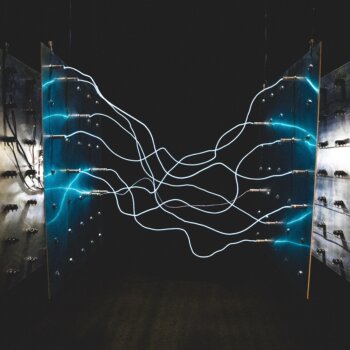Think back to when you were in school learning about Greek mythology or the Industrial Revolution. Weaved into those “dry” textbooks and lectures were brilliant pieces of art—paintings, sculptures, or architecture—that brought to life the moments and ideas that would otherwise appear distant and dull.
Art is an important tool for educating society about our cultural and natural histories. It’s also useful for identifying and solving our present challenges. Art is a “form of technology” that can facilitate “moral knowledge” and engender empathy, as well as act as a “form of communication” and a universal language. Put simply, art can shape society. That’s why, according to researchers Ramya Srinivasan and Kanji Uchino, we should tap into the arts to educate society about artificial intelligence (AI). In particular, they write, “art has the potential to reduce the barrier in educating laypeople about AI ethics.” It also has the potential of ensuring the AI decision process caters to its consumers by serving as a platform to understand the opinions of people impacted by AI systems and further, foster empathy between AI creators and the people impacted.
Related Works
While work is being done to mitigate and understand the harmful impacts of AI on society, there are still gaps. In particular, the authors point out that while there is a growing body of multidisciplinary research from the AI community to “build ethical AI systems,” it has largely failed to address “issues related to [the] power structure imbalances that have adversely impacted specific communities.” Srinivasan and Uchino suggest that previous research on the “interplay between arts and technology” indicates how art can help “shape AI ethics” and correct the aforementioned imbalance by “aiding in AI education, serving as a medium for voicing opinions, and by fostering empathy.”
Art as a Tool for AI Education
The relationship between art and science is well-documented. From 18th century astronomers to 20th-century nuclear physicists, scientists have often recorded their findings and theories through drawings. In fact, Albert Einstein once remarked, “some of the greatest scientists are artists as well.”
Art is also largely universal, appealing across cultures, generations, and languages. It’s a form of communication that can more easily convey a “hard concept” to a large group of people—this is vital for educating individuals about AI and AI ethics. We should all have a basic understanding of these systems, no matter our technical knowledge, because they will increasingly impact every area of our lives. With this in mind, many organizations are starting to create programs that fuse art with AI, including MIT Media Lab’s “Dancing with AI” in which students learn to “think of algorithms as opinions” and are “taught to consider direct and indirect stakeholders in a system.”
Of course, there are challenges. As alluded to above, not every art form is universal. A witty puppet teaching about bias in algorithms may appeal to a preschooler but not a twenty-something college student.The authors also point out that there is a “lack of art creators” with a good enough understanding of AI and AI ethics to create pieces that can serve as an effective education tool. Another barrier, which exists across the AI ethics space, is the predominance of research and projects “largely catered towards groups who are literate and fluent in English” and that do not “involve stakeholders who are impacted by the AI’s decisions.”
Art as a Tool for Expression
From music to murals, artists have historically used art to “voice opinions about social, political, economic, and other societal aspects.” We’ve seen this most recently with artists designing murals and art installations to protest the military coup in Myanmar. With this in mind, the authors argue that art can give people a platform to “express their views about how they have been impacted by AI, what values they want AI to care about, and what their expectations of AI [are].” In addition, AI researchers can use art to “expose drawbacks in the AI pipeline.” In fact, some already have. In 2019, AI researcher Kate Crawford and artist Trevor Paglen created an art project called ImageNet Roulette (now Excavating AI) which exposes the systemic biases present in Imagenet, “one of the instrumental datasets in advancing AI.”
Art as a Tool for Enhancing Empathy
The authors open this section with a poignant quote by French-American artist Louise Bourgeois: “Art is restoration: the idea is to repair the damages that are inflicted in life, to make something that is fragmented – which is what fear and anxiety do to a person – into some-
thing whole.” In other words, art is healing. By evoking empathy, art bridges the profound gaps that exist between human beings, allowing us to recognize different viewpoints, “engender moral values,” and even “help cultivate societal ethics.” In many cases, art forces us to first recognize and then empathize with people that we otherwise may never have come into contact with.
In addition, many in the AI community have recognized the “need for designing AI systems with empathy.” This is key in correcting the current power imbalances in AI referenced earlier. Encouragingly, a workshop titled “Resistance AI” at the 2020 NeurIPS conference aimed to address this issue by inviting multimedia art submissions that “highlight power disparities in the AI pipeline.” Workshops like this also allow for other ideas regarding issues in AI ethics, such as transparency, fairness, and bias to be conveyed in ways that are outside the “mainstream” understanding. Finally, art can also act as a reflection tool for AI researchers and developers by visually depicting the effects of a decision made by an algorithm—turning the impacted populations from a distant user into a relatable individual.
Conclusion
In conclusion, Srinivasan and Uchino acknowledge the limited nature of this paper, encouraging others to pick up where they left off. While they broadly outline the ways in which the arts can help shape AI ethics, there is still much to be done in order to understand how we can effectively operationalize this idea. There is no doubt, however, that there is “tremendous potential” to do so.
Between The Lines
Although this research raises more questions than it answers (outlined in the full paper), it no doubt serves as an important stepping stone for further research and affirms what many science communicators, like myself, have long believed: we must cultivate artistic sensibilities as much as scientific thinking in our children. This is especially important to recognize and express at the highest levels of the scientific and political communities because schools are increasingly forced to defund their art programs due to budgetary cuts.
Finally, a particular question posed by the authors deserves further investigating: how can we effectively and concretely integrate these forms of artistic expression into the development of AI systems? As many in the field of AI ethics acknowledge, we struggle with putting ideas and theories into practice. If we are to ask members of communities most likely to be negatively affected by AI systems to express their views and opinions through art, there must be a commitment to integrating that knowledge to build more ethical systems. Otherwise, we risk causing further harm.
About the Author
This article was written by Victoria Heath





























